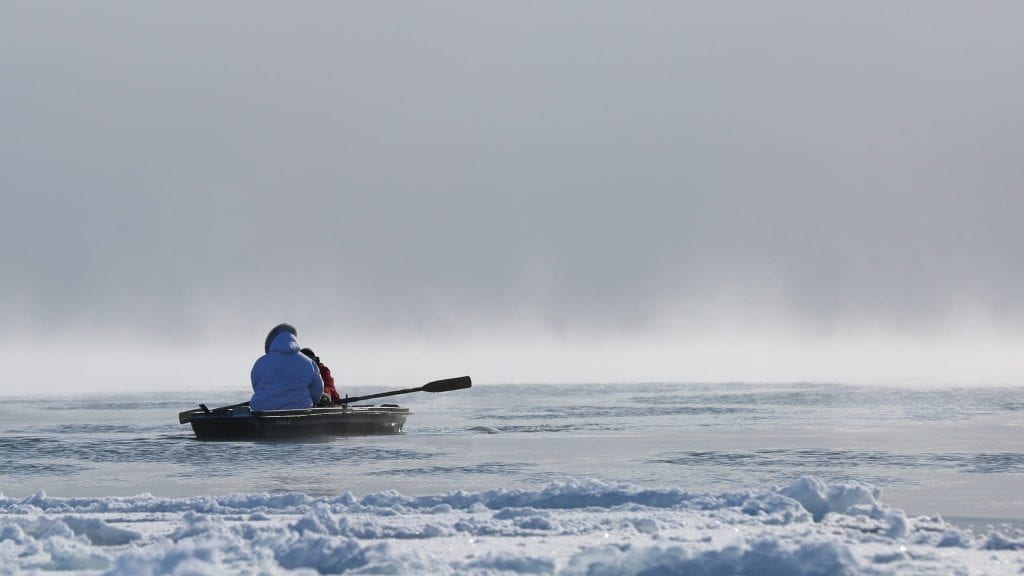
Guest post by Noelle Ibrahim.
Themester intern Noelle Ibrahim had a conversation with Stephanie Kane, an International Studies professor at IU. They discussed the central tensions captured in the upcoming Themester film, Angry Inuk. Dr. Kane’s new course, INTL-I 302 Arctic Encounters: Animals, People and Ships, explores the ever-evolving Arctic sphere and competing interests within the region.
You suggested Angry Inuk for Themester 2018. Why did you suggest it?
Kane: A colleague who has watched many films and is an Arctic expert suggested it to me. I thought that the topic helped give people an understanding of the somewhat fraught relationship between people in the Arctic and environmentalists over some particular issues. There are many cases in which environmentalists work together with indigenous people, such as in the No DAPL (Dakota Access Pipeline) fights against the pipeline. But sometimes they see themselves on opposite ends of issues, and it’s important to understand that and figure out how to work through it.
How do you see those relations as having developed since 2016, when Angry Inuk was released?
Kane: I think there’s a lot of hard feelings that are still present. I went to one workshop as a part of the Ice Law Project, which I’m a part of, and there were people who talked about this and were still quite angry at the way mainstream environmentalists have treated them and kind of purposely misunderstand their situation, which comes across in the film.
In what ways do you see popular culture and mainstream environmentalists misunderstand the Arctic and the needs of the people and animals within it?
Kane: As it shows in this film, it’s not simply a matter of misunderstanding; it’s willful ignorance. Greenpeace as well as other animal welfare organizations are global organizations that have impacted legislation in the European Union, for example, and have campaigns that are misleading. They put charismatic megafauna up there, hand out little fluffy animals, and appeal to people’s compassion. According to the filmmaker, this brings them millions of dollars. These organizations keep doing so despite the fact that the Inuit have tried to explain and to teach them that they’re being harmed by the legislation that they continue to promote. Basically, they get themselves off the hook by saying, “Well, there’s an exception for the Inuit.”
What happens, however, is that these laws collapse the seal market. It doesn’t matter if there’s an exception for the Inuit if there’s no seal market. The way the Inuit hunt seal is sustainable and it’s also a key part of their economy. So, when people keep referring to them as, “Oh, those cute little Inuit that go around with bows and arrows and dog-sleds,” it’s misrepresenting their need to have a viable way of participating in the global market. Their only alternative is mining, such as petroleum mining, and uranium mining, and all that stuff that the environmentalists supposedly don’t want to happen. It’s a very fraught relationship.
The other thing the film does well is show how the filmmaker keeps trying to meet with the people in these organizations and have these conversations, but they keep refusing to communicate. So, it’s not simply that these organizations need to understand, because they don’t want to understand. That would undermine their message, which is working very well for them.
I say them, but I’m a member of Greenpeace. Watching the film made me want to stop my membership and write them a letter and tell them why. I think this is why it will be important for people to see the film because a lot of times we don’t do things directly, we give money to organizations that we hope will do the right thing in our name, but oftentimes they don’t. This is one of those instances. We need to understand that and figure out how not to delegate to people that are going to do things in our name that we do not want to happen. I think that’s what the discussion will be about.

Did you find anything surprising about the film?
Kane: Yeah! I was surprised to the extent that Greenpeace and the other animal rights organization in the film refused to listen, or even meet.
In one occasion the Inuit traveled a long distance because the environmental activists said they were going to have a protest somewhere. The Inuit came from very far away just so they could have a conversation, and when they [the environmental activists] heard that the Inuit wrote to them and said, “We’re going to meet you there,” they cancelled it. That really surprised me; that people who care about something are just putting things in boxes.
Not only are they implying that they just want to protect the animals and not the people, but even the little, white, baby seal is not endangered nor a part of their world. It’s false, and so it’s no better than Coca-Cola, or any of these other advertising agencies. The extent to which that was happening surprised me.
Angry Inuk seems to respond to our blanket perception of environmentalism as “good” by providing a deeper look at how mainstream environmentalism has negative consequences for certain populations…
Kane: I think the idea we all have to learn, and that I learn all the time in my book on water infrastructure, is that you can’t really build anything without hurting somebody.
You usually try to do the most good, and then mitigate the harm that you cause as a result of doing the most good for the most people. But if you refuse to acknowledge the harm, then you’re making these rifts of dispossession and inequality ever-deeper.
I used to think I would never buy furs, but now I don’t think of it so generally. By buying seal skin that’s harvested in a particular way by particular people, I’m helping to allow them to live in a clean world without miners coming in.
The film has altered my notion of furs in general. But maybe you look at the mink industry or the fox industry and it’s a different situation. Each of these need to be looked at separately. It’s like eating chicken; maybe you don’t mind eating chicken that runs loose on a farm, but you don’t want Perdue chicken. We’ve parsed our food, but we haven’t really thought about some of these other categories that we’re banning.
You can see Angry Inuk at the IU Cinema on October 8 at 7 pm. This screening is part of the Themester series, which is sponsored by the College of Arts and Sciences and IU Cinema and is supported through the Cinema’s Creative Collaborations program.

Noelle Ibrahim is a junior studying English and Arabic with a minor in marketing. She is interning this fall with the Themester program as it focuses on “Animal/Human” and looks forward to studying in Amman, Jordan in the spring.